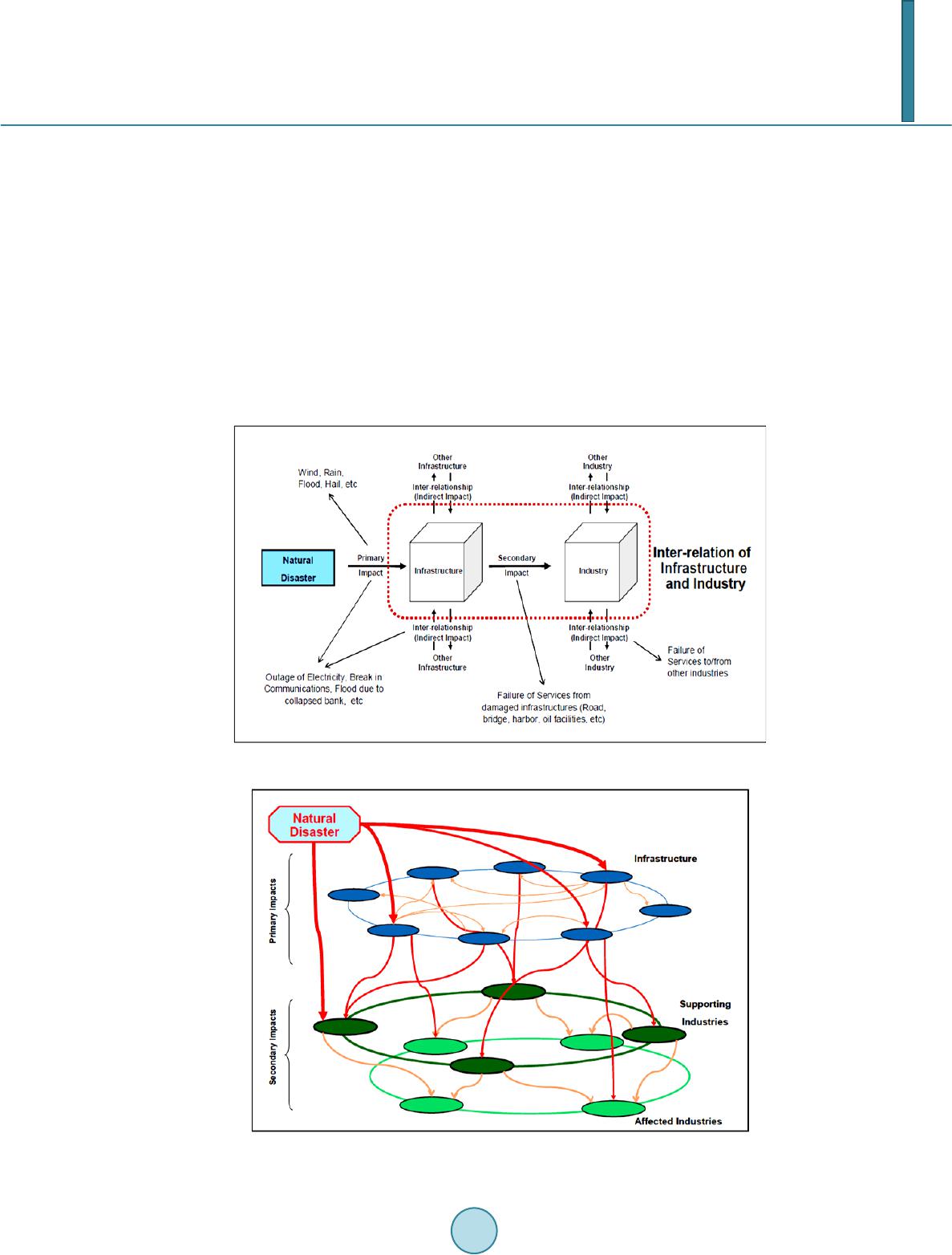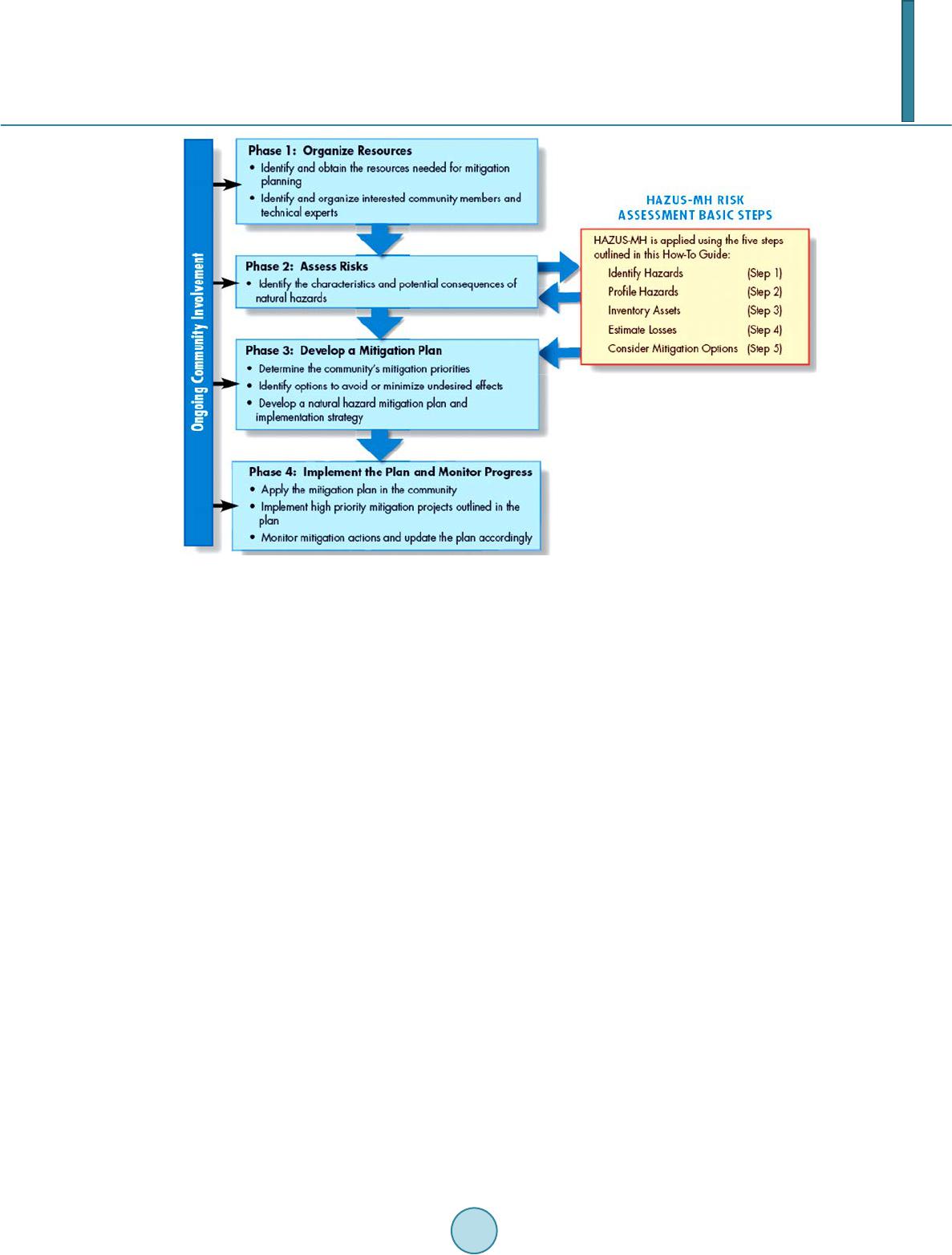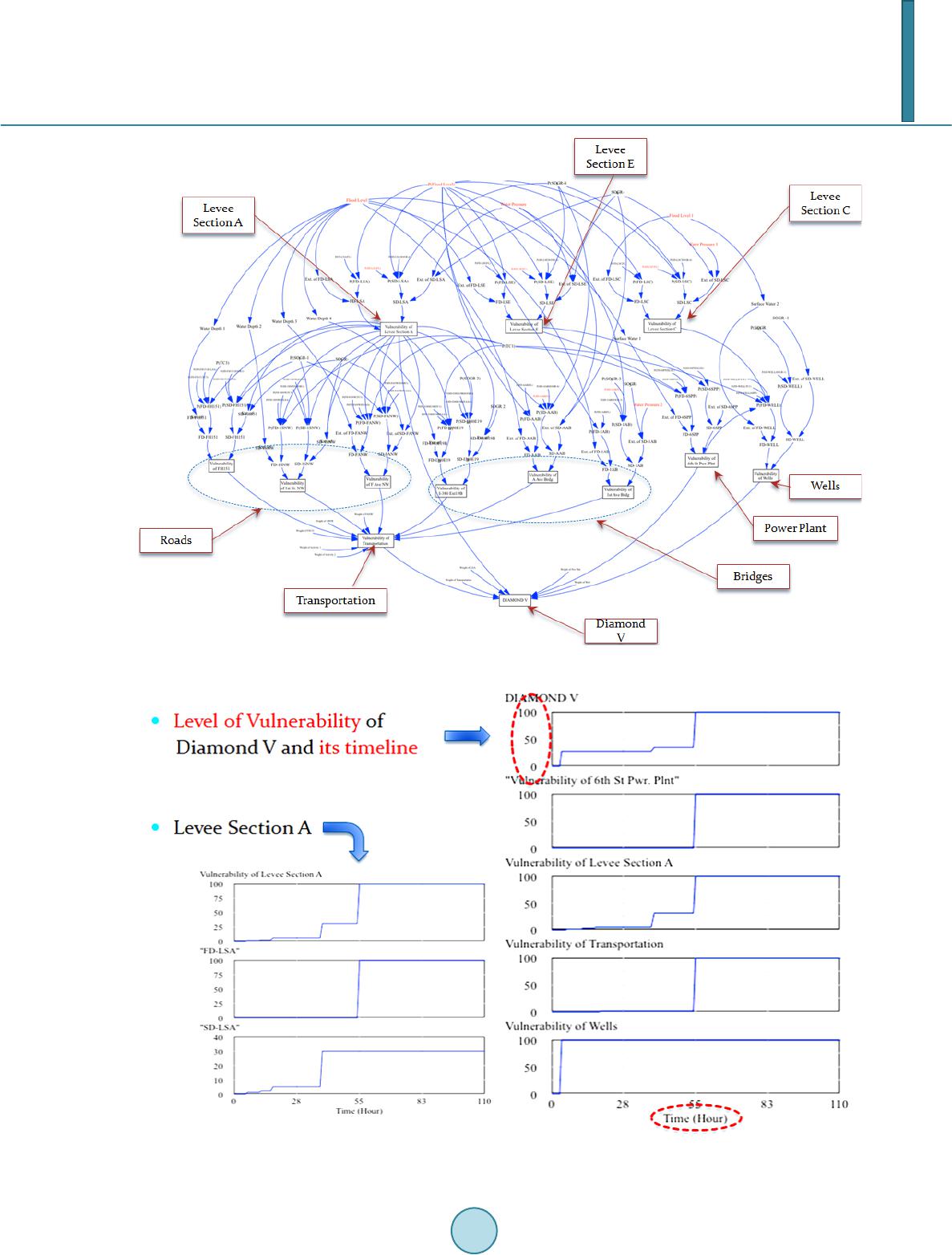 World Journal of Engineering and Technology, 2014, 2, 27-35 Published Online September 2014 in SciRes. http://www.scirp.org/journal/wjet http://dx.doi.org/10.4236/wjet.2014.23B005 How to cite this paper: Oh, E.-H., Kim, K.-T., Kim, K.-H., Kim, J.-M. and Cho, J.-W. (2014) Development Strategy of Infra- structure Risk Assessment Based Disaster Response and Management System. World Journal of Engineering and Tech- nology, 2, 27-35. http://dx.doi.org/10.4236/wjet.2014.23B005 Development Strategy of Infrastructure Risk Assessment Based Disaster Response and Management System Eun-Ho Oh1, Kyoon-Tai Kim1, Kyong-Hoon Kim1, Jin-Man Kim2, Jin-Woo Cho2 1Construction Management & Economy Research Division, Korea Institute of Construction Technology, Goyang-Si, Gyonggi-Do, South Korea 2Geotechnical Engineering Research Division, Korea Institute of Construction Technology, Goyang-Si, Gyonggi-Do, South K orea Email: uno1988@kict.re.kr, jmkim@kict.re.kr Received May 2014 Abstract Major infrastructures such as levee, dam, bridge, road, etc. have a significant meaning in that they are the means to support ordinary social and industrial activities and also protect human and physical assets at the occurrence of disaster. Especially, integrated risk management of SOC facili- ties provides the policy maker in charge of SOC facility safety and related disaster prevention with a reasonable means of decision making and ultimately contributes to improving the safety of the applicable SOC facility. Furthermore, a variety of issues raised in the Sewol ferry disaster that oc- curred recently in Korea, such as, a proper response method and the relevant Golden time deci- sion making at the occurrence of disaster, rapid grasping and reporting the situation on disaster sites, management and mobilization of resources for rescue and recover, loss of integrated control tower function, etc., might occur as well in facility disaster management. As the method of solving such issues adequately, this study suggests a strategy of new disaster response and management system. The analyses of Hazus-MH (FEMA) and DIMSuS (Purdue University) were compreh e nsively conducted, and based on the results required functions of new disaster response system of major infrastructure and its development directions were suggested. Keywords Infrastructur e, Risk Assessment, Dis as ter , Re sponse, Decision-M aking 1. Introduction Major facilities such as levee, dam, bridge, road, etc. have a significant meaning in that they are the means to support ordinary social and industrial activities and also protect human and physical assets at the occurrence of disaster. Especially, integrated risk management of SOC facilities provides the policy maker in charge of SOC facility safety and related disaster prevention with a reasonable means of decision making and ultimately con-  E.-H. Oh et al. tributes to improving the safety of t he applicable SOC facility. Furthermore, a variety of issues raised in the Se- wol ferry disaster that occurred recently in Korea, such as, a proper response method and the relevant Golden time decision making at the occurrence of disaster, rapid grasping and reporting the situation on disaster sites, management and mobilization of resources for rescue and recover, loss of integrated control tower function, etc., might be occurred as well in facility disaster management. As the method of so l vi ng such iss ue s ad e qua te l y, t his study suggests a str ategy of ne w d i saste r res po nse and ma na ge me nt s yst e m. 2. Establishment of Risk Assessment Concept It is necessary to establish a concept of risk assessment in advance in order to build DRiMSS (Disaster Risk Management Support System), ground of which, is an integrated risk management. In this study, risk and as- sessment concept of DIMSuS developed by Purdue University and Hazus-MH developed by FEMA were ana- lyzed, and then a new concept of risk assessment was established. 2.1. Concept of Risk Assessment in Hazus-MH Risk assessment of Hazus-MH was develope d aiming for guiding each local govern ment in establishing its plan for risk analysis and disaster mitigation under the Disaster Mitigation Act (Disaster Mitigation Act of 2000). Disaster mitigation plan required under the Disaster Mitigation Act, however, is designed to handle the devel- opme nt of dis aster manage ment p olic y and enfor cement guid elines, risk ana lysis a nd miti gatio n tec hniques , and loss forecasting technique, etc. in general, while the risk assessment of Hazus-MH is based on loss forecast de- signed to as sess the leve l of ri sk following the scale o f da mage to maj or facilities, loc al c ommunit y and i ndu str y except facility or disaster risk management in consideration of probability. 2.2. Concept of Risk Assessment in DIMSuS Risk handled in DIMSuS represents the degree of risk (Risk, Threats) affected to society and industr y by disas- ters. Its value depends on the condition of major facilities, and the risk is calculated by the probabilistic method . Broadly, the risk of facility is decided according to the probability of damage that may occur and the size of damage related with functional destruction and structural destruction. Probabilities of functional and structural damages are derived based on the damage arising from the occurrence of flood, that is, Bayesian Network using the conditional probability, and the mechanism of functional and structural damages is realized and final risk that may impact o n soc ie ty and industry is calculated using the S ystem Dynamic s Simulation technique. Hazus-MH simply provides risk manager with information such as flooded area, scale of damage, etc. while DIMSuS pla ys a role of supporting decision maki ng so that risk manager can properly judge related with man- agement of damaged region and response to the region. Especially, it suggests the procedure of assessment thro ugh DI MS uS-3D (3 -Dime nsio n) so tha t D IMS uS ca n co nduc t cri sis ma nage ment a t t he o ccur rence of disas- ter, and indicate the basic poin ts of EAP (Emer gency Action Plan) by facility types. 2.3. Establishment of the Con cept of Risk Assessment in DRiMSS In est ablis hing t he co ncept o f risk a sses sment p ursued by D RiMS S in thi s stud y, it i s desirable to introduce and apply the concept of DIMSuS aimed at decision making of the risk manager rather than Hazus-MH that simply provides infor mation. T her efo re, o verall infor mation s uch as EAP for majo r facilities i n for ce-land and the facil- ities in frequently flooded area of protected lowland should be provided on the assumption that safety informa- tion and failure p r obability related with the facility are provided o n a real time basis to DRiMSS. DIMSuS, however, falls short of grasping the scale of damage in the applicable region and related decision making, and therefore the suggestion of comprehensive EAP using the information of damage analysis in the DRiMSS should be included . Final prod uct of DRiMS S risk asses sment consis ts of level o f risk b y major facili- ties, result o f risk a nalysis for the app licable re gion, a nd infor mation in detail of E AP of the major facilitie s and the applicable region. 3. Facility Impact Flow Analysis for Risk Assessment DRiMSS risk asses sment is conducted r elated with a primary risk affected to the water front structure at the oc- currence of disaster and the secondary or direct/indirect risk of the society and industry in the vicinity that may  E.-H. Oh et al. occur from the destruction of water front structure. Therefore, it is important to grasp physical vulnerability of water front structure to which the external force is directly applied when the disaster such as flood, etc. occurs in the be ginni ng and t he pr obab ility tha t suc h vulne rabil ity ma y occur . In ad ditio n, it is nece ssary to gr asp the ris k that may occur in succession in the ambient structure, residential area or industrial area being transferred secon- darily thereafter. Accordingly this study intended to analyze the flow of impact as well as disaster risk mechan- ism required for ri sk ass essme nt. According to Oh (2008), natural disaster impact applied to the facility or related society/industry through ba- sic cell model is divided into Primary and Secondary steps. Primary step means physical impact from natural disaster being directl y applied to the facility, which i s a step causing physical d amage or loss. For example, ty- phoon is accompanied by the destructive force such as wind, rain, flood, tidal wave, etc., which comes to cause direct damages such as flooding, destruction, colla pse in par t, e tc . to the facilities (F i gure 1) [1]. Secondary step is the stage causing secondary damages such as flood, outage of electricity, break in commu- nications, br idge collapse, ro ad flooding, etc. to the facilitie s or industr y in one or two-wa y connection with the facilities that underwent damage. Such disaster impact or damage route was illustrated in Figure 2. Figure 1 . Disaster i mpact mechanism: Basic cell model ( Oh, 2008). Figure 2 . Conceptual disaster impact diffusion route (Oh, 2008).  E.-H. Oh et al. Pattern of disaster impact diffusion depends on the regional characteristic of the area where disaster occurs. Therefore, it is necessary to decide a specific region as the test b ed in orde r to develo p DRiMSS that is t he final aim of research in this study, analyze the c haracteristic of societ y and industry in the applicable region, and ana- lyze the degree of mutual supporting and dependency relationship between the major facilities that support the same. In add ition, it is es sentia l to exactly gra sp inter -relationship between the facilities based o n flood scenario to analyze the flow of impact that is deployed at the occurrence of flood. Inter-relationshi p b et ween the facilitie s explains which facility is primarily exposed to risk or impact at the occurrence of flood geographically, which facility or socio-industrial entity undergoes sequential impact directly or indirectly when the facility is flooded resulting in f unctional/structural d e str uction, etc. 4. Analysis of Decision Making Supporting System Related with Risk 4.1. Analysis of Hazus-MH Risk Assessment Elements and Meth o d In America, there are the statutes related with disaster and disaster management such as Robert T. Stafford Dis- aster Assistance and Emergency Relief Act, Disaster Mitigation Act (2000), Homeland Security Act (2002), HSPD-5, etc. They establish a disaster management system in accordance with “Comprehensive Disaster and Safety Management Technology Development Plan (2007)” of SDR (Subcommittee on Disaster Reduction) un- der contr ol of NSTC re la te d with 6 policy directions to mitigate disaster r isk in future. 6 policy directions aimed in this comprehensive plan are “1) Use of natural and human disaster technolo gies to prevent terror, 2) Establishment of disaster information and reinforcement of forecasting competence, 3) De- velopment of ris k assessment model a nd its linkage to d ecision making supp orting system , 4) Rapid applic ation of hazard study, 5) Increase in mitigating technology activity and its incentives, 6) Reinforcement of risk com- munication competence and public alert system technique.” Based on such legal ground and recommendation, USA operates disaster management system including the homeland security concept such as terror, etc. in the response to disaster, and uses the technological alternative such as disaster manageme nt purp ose communication system ( AMSC SkyCell system, mobile satellite commu- nicat ion s yste m) and GIS-based disa ster manage me nt syst em (H az us-MH) against natural disaster such as earth- quake, hurricane, flood, etc. This paragraph analyzes Hazus-MH disaster damage based risk assessment proce- dure . In case of flood model, Hazus-MH visualizes flooded area and is very effective in calculating the scale of di- rect and indirect economic damages and damage for humans (social damage) based on inventory information. FEMA suggests the procedure of risk assessment (How-To Guide) based on this Hazus-MH in detail (FEMA, 2004) [2]. T his assessment proc edure is designed to guide t he establis hment of risk anal ysis and disaster mitiga- tion plan that had to be conducted by each local government under the Disaster Mitigation Act enforced from 2000, which was developed as the demonstration application guideline of Hazus-MH. Disaster mitigation plan required by the Disaster Mitigation Act includes development of disaster management policy/enforcement guideline, risk analysis/mitigation technique, loss forecasting technique, etc. As the tool to cope with the same, FEMA suggested 4-step risk assessment procedure based on Hazus-MH, whic h consists of Organize resources, Assess risks, Develop a mitigation plan, and Implement the plan and monitor. Basic 5 steps of risk assessment incl ude Identify hazards, Profile hazards, Inventory assets, Estimate losses as well as and Hazus-MH s i mulatio n, and Consider mitigatio n option (Figure 3). Nevertheless Hazus-MH is a tool aimed at damage estimation, but not a risk management tool for facility or related entity by probability. 5-step risk assessment procedure as aforementioned calculates in advance flood level and facility flooding damage of the applicable region using rainfall information given before the occur- rence of flood or hurricane playing a role o f providing prior infor mation to mitigate dire ct/indirect damage, b ut Hazus-MH itself doesn’t directly provide the risk information following the elapse of time. For example, it is impossible to provide regional risk information changing from moment to moment at the occurrence of flood, vulnerabilit y by facilities, information on the response by stages, etc . in Hazus-MH. 4.2. DIMSuS Unit and Whole Risk Assessment Algorithm Unit algorithm of DIMSuS expressed the System Dynamics is divided into the flows of calculating two parts such as functional and structural risks. Bayes’ theory is its central logic to calculate the sizes of occurrence  E.-H. Oh et al. Figure 3 . FEMA’s Hazus-MH based risk assessment procedure (FEMA, 2004). probability and vulnerability, which is based on the conditio nal p rob ab ility that preced ing event gi ves co nditio n- al impact to la ggi ng eve nt [3]. This is because it is adequate for the calculation of risks of neighboring community, industry, and public fa- cility where damages take place sequentially in connection of geography and time from the risk of destruction that starts from levee at the occurrence of flood disaster. Figure 4 shows how the two preceding events such as Flood Level (FL) and State of Good Repair (SOGR) affect impact functionally or structurally to the levee. In case of functional risk, it reaches to 100 percent when the levee simply o verflo ws, that is, flood level is higher t han the height o f levee, and ther e for e it is nothing to d o with the condition of levee. Meanwhile, in case of structural risk, the pattern of destruction varies depending on the condition of levee; sound (SOGR1) or very vulnerable (SOGR4), and therefore it requires both flood level and status information as the preceding events. Figure 5 shows the flow of the least unit impact that cause structural/functional r isk (vulnerab ility) to the le- vee by the factors that generates the risks such as flood level (FL), facility condition (SOGR), pressure (Water pressure), etc. Unit algorithm of DIM SuS can be diffused to the unit of maj or facilities such as bridge, r oad, p lant, etc. start- ing fo rm leve e. Figure 6 as b elow sho ws the fi gure exp anded into the whole ri sk asse ssment algo rithm r egard- ing the Diamond V a chai n company in the region using t he unit al gorithm [3]. The resul t of DI MSu S ris k ass ess ment i s de rive d in the fo rm o f grap h pr ovid ed b y the S yste m Dyna mics , a nd expressed in the size of risk on Y-axis and the elapse of time on X-axis (Figure 7). For example, total sum of functional risk (FD-LSA: Functional Damage of Levee Section A) and structural risk (SD-LSA: Structural Damage of Levee Section A) comes to the risk of Levee (Levee section A) that is the unit facility. Comprehensive risk of industry (Diamond V) is the total sum of the individual risks transferred through inter-relationship from power plant, transportation facility, levee, pump (waterworks), etc. In this case, the weighted value by facilities applied to get the sum of risks are those decided in advance by expert’s opinion and inter-relationship betwee n facilities (Level of Criticality). As such, DIMSuS expresses the risks transferred from flood disaster in a graph by assessing them in func- tional/structural manner, and create/provide the relative risks suitable for manager or policy maker, but fails to provide exact damage information based on GIS and inventory information like Hazus-MH. Furthermore, it re- quires information on SOGR as the first input data and destruction probability of the levee based on it, which,  E.-H. Oh et al. Figure 4. Conditional probability based functional/structural risk flows (Oh, 2010). Figure 5 . Unit algorithm of DIMSuS model (Oh, 2010). however, is a theore tical assumptive value onl y. In fact, destruction p robab ility of the levee is decided by piping and activity that occurs inside the levee and the overflow that occurs outside, which arises from complex reac- tion of a variety of conditions such as flood level, flooding time, material property of levee, design method and scale, size or length of collapsed area as well as the information of condition of the levee. That is, even Nether- land and Japan, etc. advanced in the levee cannot officially provide destruction probability based on such factors of destruction so far. Accordingly, in order to supplement disaster decision making system based on DIMSuS facility risk, it is necessary to derive the levee destruction mechanism, and apply levee destruction probability based on overflow, activity, piping, etc. 5. Development Dire c tion for Facility Risk Assessment Based Disaster Risk Management Supporting System Hazus-MH enables exactly to the scope of actual flood area and damage to manor facilities based on precise in- ventory/DEM/flooding model information. It also calculates damage information covering direct/indirect damage  E.-H. Oh et al. Figure 6 . Industry risk assessment algorithm of DIMSuS model (Oh, 2010). Figure 7 . Indication of result of DIMSuS industry risk analysis (Oh, 2010).  E.-H. Oh et al. such a s facil ity, co mmunity a nd ind ustry, e tc., and secure s scientific and ob jective data. Ho wever, it is difficult for the manager to oper ate it as it adopts ArcGIS geographica l information across U.S.A and inventory. Meanwhile, DIMSuS considers conditional probability owing to flood and the inter-relationship of the appli- cable area and the degree of criticality and risk by facilities (SD, FD), and therefore enables to grasp the risk ap- plied to the facility in accordance with the scenario (time, flood level, etc.). In addition, the input data includes the socio-industrial criticality of the applicable area facility and therefore it may provide priority level of the restoration stage afterwards as well as risk assessment. However, input data in part includes the opinion of ex- perts or residents in the applicable region, and the level of risk calculated is expressed in a relative value, which is helpful in decision making but inadequate for the calculation of exact level of risk and scale of damage. As result of analyzing the method of risk assessment related with the afore-mentioned two systems, it is deemed desirable that DRiMSS should apply the same simulation technique adopted in DIMSuS for the follow- ing reasons, and it is necessary to build a DRiMSS risk assessment model by applying the System Dynamics simula tion tool that may satisf y the following cond ition. ● Water disaster management system targeted by DRiMSS i s same as that by DIMSuS ● DRiMSS includes complex and a number of factors (facility) ● Inter-relatio nship between the constitutional factor s of DRiMSS can be expressed in conditional probability of Bayesian Network based on the water disaster ● Inter-relationship of DRi MSS is expressed in a fixed formula ● Result of DRiMS S simulation is expressed in a continued data such as flood curve , risk, etc. ● Cons truct i on of DRiMSS si mulation s ystem is realized at the macro level as shown in DIMSuS In addition, as result of bench-marking of the advantages of Hazus-MH and DIMSuS as shown in Table 1, DRiMSS is required to exert the specification and performance as follow. Table 1. Comparison of Hazus-MH and DIMSuS. HAZUS-MH D IMSuS Technique - ArcG IS - Inventory system - Flood and damage calculation model - Impact Flow Analysis - System Dynamics techniqu e - Bayes’ Th eory Input information - Inventory (Nati onal Inventory) - Flood Information(USGS) - DEM information - Flood Scen ario - AHP Result (information on the degree of criticality, etc.) Calculation infor mation - Sc ale of dir ect/indirect loss (abs o lut e val ue) - Calculation of the scale of social damage - Degree of criticality of the facility - Facility risk (SD, FD) • SD (Structural Damage): Facility structural risk durin g disast e r • FD (Functional Damage): Facility functional risk durin g disast e r Disaster management 4 steps Applicable scope - Long-term response - Response just befo re - Follow-up response - Long-term response - Response just before - Response at the occurrence ( ev acuatio n, rescu e, etc.) Manager (View point) - Government - Government - Industry - Local r esident Advantages - GIS-bas ed macro expression system - Exact forecast value - Scientific and quantitative calculation method - Relative criticality of the facility for making decision durin g disast e r - Provisi on of disaster scenario f ollowing the elapse of time (Impact Flow) - Provision of facility risk information related with the facility (SD, FD, etc.) Disadvantages - Lack of concrete mitigati on plan for commun ity and industry - Requ irement o f heavy GIS software - Lack of visible expression system - Relative value instead of a bsolute va lue - Focused on the expert’s opinion  E.-H. Oh et al. <From DIMSuS> ● Conditional p robab ility calc ulation method based o n inter-relationship of the facility ● Function of si mula tion that enables to r e produce the syste m and provide the information repeate dly ● Active decision making sys t em that may response just before and during the disaste r ● Provision of risk information by facilitie s ● Assessment o f the criticalit y of facilit y for lo ng-term response and follow-up restoration related with disaster (provision o f priorit y level) <From Hazus-MH> ● Use of geographical information based on detailed and accurate GIS ● Establish ment of de ta ile d inventory on the facility in the prote c te d lowland and for c e-land (Total inspection) ● Calculation of detailed and accurate direct/indirect damage based on the Damage Curve by facilities ● 2D expression based on GIS In addition, it is necessar y to build DRiMSS as the decision making system improved in consideration of ad- ditional performances of the system that cannot be provided by Hazus-MH and DIMSuS as follow. ● The function of comprehensive assessment of the real-time based information by sensor delivered from the monito r i ng s ystem ● Realization o f levee d e struction proba bility mechanis m (in consideration of overflow, activit y, piping, etc.) ● Supporting the facility manager to make proper decisio n (i t mu st b e t he ma ki n g of a ct ua ll y va r ious d ec isi o n s and the en forceme nt method thereby rathe r than the pr ovision of simple informa t ion) ● GIS-based 3D expression and SNS information diffusion system 6. Conclusion Facility risk assessment based DRiMSS suggested in this study is a first step for building advanced country type facility safety management and disaster response systems through integrated operation and linked technology, which would provide the basis for the existing manual disaster management system driven to human/physical damage mitigation to be converted into active response system that actively uses the facility. Currently DRiMSS has already been built in its conceptual design and establishment. For 4 years from now, its actual system estab- lishment and demonstratio n experiment in the test bed region will be p romoted. Acknowledgements This research was supported by a grant (13SCIPS01) from Smart Civil Infrastructure Research Program funded by Ministry of Land, Infrastructure and Transport (MOLIT) of Korea government and Korea Agency for Infra- struc ture T echnolog y Advancement (K AIA). References [1] Oh, E.H. (2008) Identification of the Impact of Critical Infrastructure on Associated Industries: Analysis of a Flood Disaster E vent. Master’s Thesis, Purdue University, Indiana, USA. [2] FEMA (2004) Using HAZUS-MH for Risk Assessment—How to Guide. FEMA 433, August. [3] Oh, E.H. (2010) Impact Analysis of Natural Disaster on Critical Infrastructure, Associated Industries, and Communi- ties. Ph.D. Dissertatio n, Department of Civil Engineering, Purdue University, Indiana, USA.
|